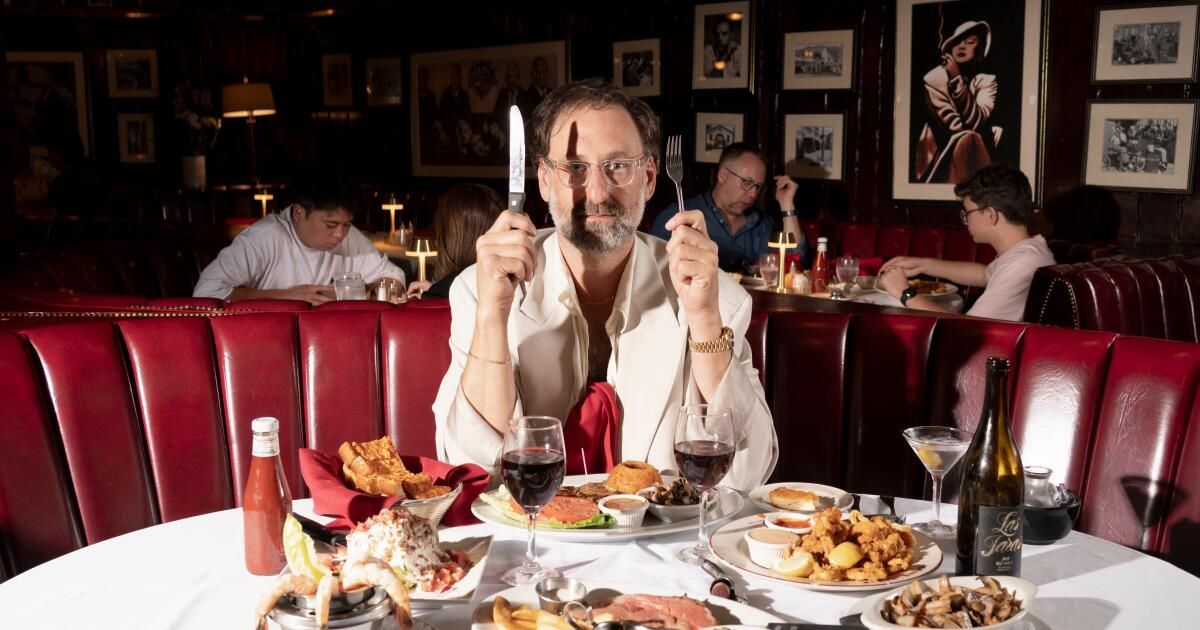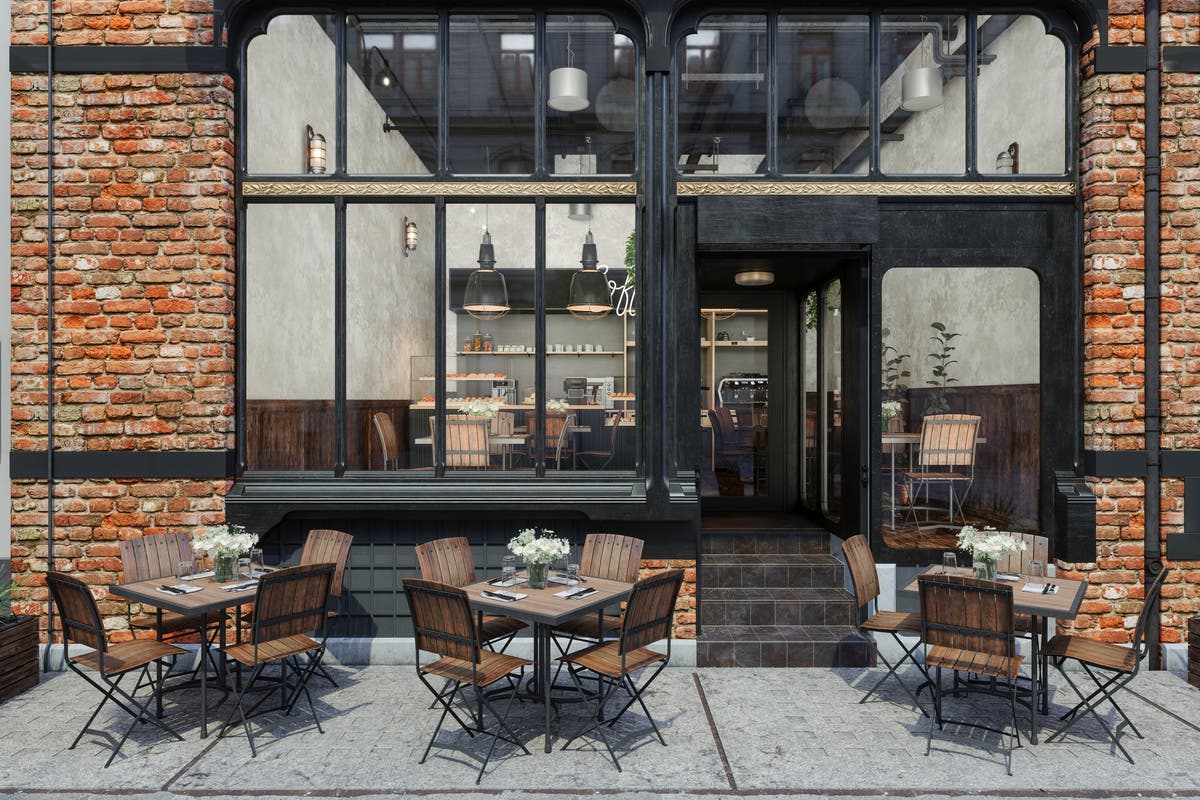For three years, Eric Wareheim ate a lot of steak.
We're talking three meat meals a day, complete with sides and sauces. Towers of stacked onion rings, bone-in ribs, bubbling pots of lobster mac and cheese, French fries, and meats smothered au poivre. His mission in touring the country was, in part, to figure out how to define the “uniquely American” institution at the center of his new cookbook, “Steak House: The People, The Places, The Recipes.”
The comedian and director who became famous with the television series “Tim and Eric Awesome Show, Great Job!” In recent years, he immersed himself in the wine trade as co-founder of Las Jaras and launched a plant art business. But of all his ventures and hobbies, “Steak House” turned out to be the most demanding and one of the most rewarding.
“I went deep and I don't regret it,” he said from a red leather booth at Smoke House in Burbank.
Eric Wareheim's new cookbook, “Steak House,” surrounded by a classic Smoke House dish.
(Gabriella Angotti-Jones / For The Times)
Wareheim, co-author Gabe Ulla, and photographer Marcus Nilsson originally set out to document the 10 “best” steakhouses in the country, but they ended up visiting more than 70 restaurants and went so far over budget that Wareheim began funding their research himself. It's been a long time, he said, since he felt that deep passion and conviction for a project.
“Honestly, I could say this project took more work and was longer than any project I've ever done, any movie or TV show I've ever written,” Wareheim said. “Because I really care about people, it was more than just vanity. It was important that I did it right.”
How to make a meat expert
Through his travels in entertainment, wine and food, Wareheim has dined at some of the best restaurants in the world. But he's never forgotten the steakhouse of his childhood, which wasn't so much a classic interpretation but a place called Seafood Shanty, located in Pennsylvania's largest shopping center. He fell in love with the big booths, the blasting air conditioning, the seafood and the steak.

While Wareheim loves a martini (gin, stirred and garnished with olives with blue cheese, ideally), “Steak House” dedicates a chapter to pairing wines with steak. His Las Jaras winery has just launched a Steak House Cabernet Sauvignon for the occasion.
(Gabriella Angotti-Jones / For The Times)
Later, he learned to eat rib-eye in a tuxedo as co-host of the veteran Beefsteak, an annual steak-centric fundraiser at Neal Fraser's Vibiana in the spirit of the utensil-less meat feasts of the 1930s described in a classic story by Joseph Mitchell.
But Wareheim doesn't just love steak. The comfort and gravitas of a worn, carpeted dining room and a menu that rarely changes are also essential to Seafood Shanty and steakhouses across the country.
“I think that's the most important story in this book: the joy that these places bring,” he said. “It's their job. It's not their job to get a Michelin star. It's not their job to write a blog or make a new dish to wow some hipster. It's to make the same consistent food for a person who's been coming here for 50 years.”
And at a time when the country feels more fragmented than ever, Wareheim sees it as a kind of connective tissue. “Everyone,” he said, “loves a steakhouse.”
The son of a German immigrant, Wareheim set out to understand the web of cultural influences that contribute to the modern American steakhouse: there are pockets of it in David Chang's interpretation at the Majordomo in Los Angeles, where flatbread (or bing) replaces traditional rolls and the ribs feature a shio koji blend. Was there an all-Vietnamese version of the steakhouse? How about a Mexican iteration?
“There are parts of this country that still feel like the Wild West, in a good way,” Wareheim said. “You can experiment, you can be anyone and open a steakhouse. You can do your own thing.”
He believes Los Angeles and Las Vegas steakhouses are leaning toward the Rat Pack era of red-leather booths and huge shrimp cocktails. But in no way do steakhouses need to follow that path or any other.
primary cuts
“Steak House” is 200 pages of pure American culture and a fragment of history that quickly disappears.
Places “would close literally a week after we were there, or they would be bought out by restaurant groups,” Wareheim said. When he arrived at Cattlemen's in Dallas, half of it had already been demolished to make way for more modern renovations. “Steak House” arrived just in time to capture some of the best mom-and-pop operations in the country.
He had been searching for inspiration, not knowing how to follow up on his best-selling 2021 cookbook, “Foodheim.”
While filming a commercial with his longtime creative partner, Tim Heidecker, surrounded by large corporate chains in North Carolina, Wareheim set about researching nearby restaurants — a pastime while on the road for each concert.
“That's all that matters,” he said. “The work doesn't matter. It's like, 'Where are we going to eat?'”
Wareheim's reputation as a restaurant curator was on the line: Beef 'N Bottle, which he had found on Google, was an hour from his hotel and he was the only one who wanted to drive.
“We get there and it's just perfection,” he said. “It was like a picture of William Eggleston. And then we met Jerome [Williams]and he greeted us with open arms and said, 'You guys are having a great time tonight, I'm your waiter and your bartender, what kind of martini do you want?' And those three things? “I get goosebumps just telling you.”
Williams and the other faces and roles that provide the charm and hospitality of a steakhouse are featured throughout, adding context and personality to a tome that offers recipes and history as well as a peek behind the curtain. There's the “basement rat” turned sommelier who worked at Tampa's Bern's for more than three decades. There's the Durpetti family of Chicago, which has been serving classic Italian and steak dishes and employs a valet who might even offer you cigarettes from their own stash. There's “legend” Katrina, dancer and waitress at Portland's famous strip club and steakhouse, Acropolis.
“Meeting the people who make these places run was a pleasure, and how passionate they were is as passionate as I am,” Wareheim said.

Wareheim's new cookbook, “Steak House,” goes deeper than the recipes, with portraits and profiles of the chefs, servers and housekeeping staff who keep the steakhouses running.
(Gabriella Angotti-Jones / For The Times)
To find these places and people, Wareheim researched restaurants online and asked chefs and entertainment friends what their favorites were. (The runaway winner? The Golden Steer in Las Vegas.)
He received rare, complete access to Peter Luger in New York City and recipe guidance from the likes of Sean Brock, Jon Shook, Vinny Dotolo and Fraser. When restaurants couldn't divulge their secret recipes, some attempts required complete reverse engineering to uncover them, a specialty of Los Angeles-based recipe developer and food stylist Jasmyn Crawford. Many of his own recipes, Wareheim said, turned out better than those of their creators.
He and his team accumulated so much material that they had to cut dozens of profiles and recipes from the final product, a process Wareheim called excruciating.
“It was brutal,” he said. “It was harder than any movie I've ever shot, any video, or any writing.”
What remained in the “Steak House” were Wareheim's best cuts. T-Pain shows off his favorite spot in Atlanta. In Los Angeles, at Taylor's in Los Angeles, Wareheim sits down with Bob Odenkirk, Heidecker and John C. Reilly and they talk about past restaurant jobs. (What is notably omitted from the book is the fact that as a teenager, Wareheim used to flip burgers and make six, then eat them while hiding in the bathroom; a co-worker tricked him and he was fired.)
Wareheim is interested in reflections as much as recipes.
What does a grill do? Does it require attention to marbling and dry aging? Should creamed spinach serve? Could it be Seafood Shanty, located in a huge shopping center in southeastern Pennsylvania? The train of thought is derailed as soon as the Smoke House waiter presents a large silver tray, with its slices of layered cakes and its ice cream-adorned pastries.
an enthusiast “Oh wow!” escapes Wareheim's lips before ordering the coconut cake. Why bother rating the steakhouse when it can simply surprise you?












